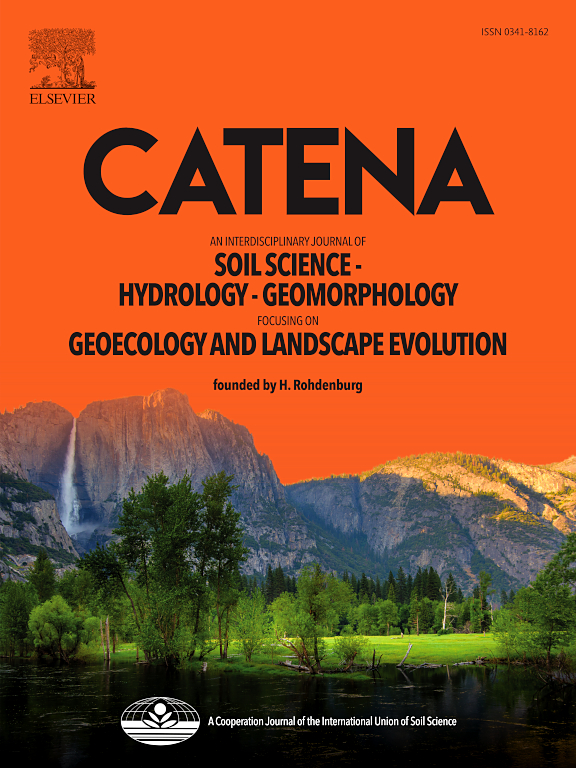养分输入控制着东亚夏季季风北缘泥炭地的固碳效率
IF 5.7
1区 农林科学
Q1 GEOSCIENCES, MULTIDISCIPLINARY
引用次数: 0
摘要
东亚夏季风北缘泥炭地是全球碳循环的重要碳库。然而,影响这些泥炭地碳通量和碳固存的主要因素尚不清楚。本文通过对东部东部北缘冈瓦窑泥炭地碳通量和固碳历史的研究,探讨了这些问题。宏观化石证据表明,在过去的4700年里,这片泥炭地从沼泽发展成了沼泽。代表固碳潜力的净碳库(NCP)、代表碳输入的净碳吸收(NCU)、代表碳损失的净碳释放(NCR)和净碳积累率(NCAR)等碳通量参数主要受养分输入控制。此外,相关分析表明,NCU对NCAR和NCAR有显著影响,进而影响NCP。NCU和NCAR受人类活动释放的氮、磷输入和土壤沉积的控制。研究区碳固存模式可分为两种类型。第一类是高固碳效率模式,人类活动和频繁的火山喷发提供了氮、磷等营养物质,促进了泥炭植被的高生产力和泥炭地的高固碳效率。第二种是低固碳效率模式,人类活动所增加的养分较少,导致泥炭植被生产力低下,泥炭地的固碳效率较低。这些结果扩展了我们对人类活动、火山活动和泥炭地固碳之间联系的理解,为未来预测东亚东部北缘泥炭地的固碳潜力提供了基础。本文章由计算机程序翻译,如有差异,请以英文原文为准。

Nutrient inputs control the carbon sequestration efficiency of peatlands in the northern margins of the East Asian Summer Monsoon
The peatlands at the northern margins of the East Asian Summer Monsoon (EASM) are an important carbon pool for the global carbon cycle. However, the major factors that influence the carbon flux and carbon sequestration of these peatlands remains unclear. In this study, we investigate the carbon flux and carbon sequestration history of the Gangwayao peatland at the northern margins of the EASM to explore these issues. Macrofossil evidence indicates that this peatland developed from a fen to a bog over the past 4700 years. Carbon flux parameters, such as net carbon pool (NCP) representing the carbon sequestration potential, net carbon uptake (NCU) representing carbon input, net carbon release (NCR) indicating carbon loss and net carbon accumulation rate (NCAR) of this peatland were mainly controlled by nutrient inputs. Additionally, correlation analysis suggested that the NCU has significant impact on the NCAR and NCAR, further affecting the NCP. The NCU and NCAR were controlled by nitrogen and phosphorus inputs released by human activity and tephra deposition. The carbon sequestration modes in the study area can be identified as two types. The first type is a high carbon sequestration efficiency mode, when human activities and frequent volcanic eruptions provided nutrients such as nitrogen and phosphorus, which promoted the high productivity of peat vegetation and the high carbon sequestration efficiency of the peatland. The second type is a low carbon sequestration efficiency mode, when fewer nutrient additions from human activities resulted in low productivity of peat vegetation and the low carbon sequestration efficiency of the peatland. These results extend our understanding of the connections between human activity, volcanic activity and carbon sequestration in peatlands, which provide a foundation for future predictions of the carbon sequestration potential of peatlands at the northern margins of the EASM.
求助全文
通过发布文献求助,成功后即可免费获取论文全文。
去求助
来源期刊

Catena
环境科学-地球科学综合
CiteScore
10.50
自引率
9.70%
发文量
816
审稿时长
54 days
期刊介绍:
Catena publishes papers describing original field and laboratory investigations and reviews on geoecology and landscape evolution with emphasis on interdisciplinary aspects of soil science, hydrology and geomorphology. It aims to disseminate new knowledge and foster better understanding of the physical environment, of evolutionary sequences that have resulted in past and current landscapes, and of the natural processes that are likely to determine the fate of our terrestrial environment.
Papers within any one of the above topics are welcome provided they are of sufficiently wide interest and relevance.
 求助内容:
求助内容: 应助结果提醒方式:
应助结果提醒方式:


